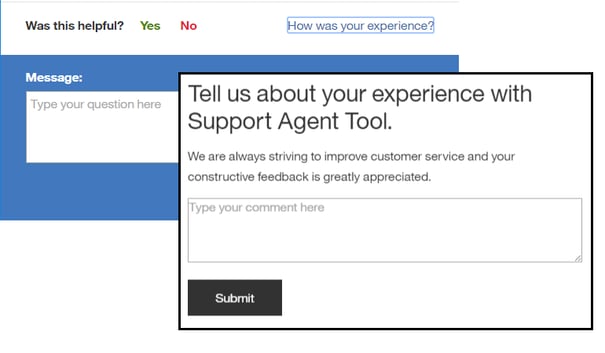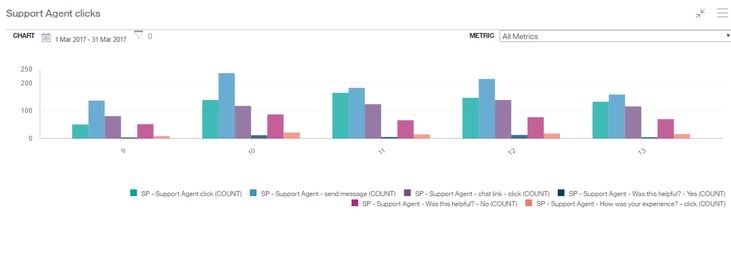Introduction
An important component of offering optimal customer experiences on your site is your ability to provide exceptional customer service. But, how do you know if the support on your site is delivering a positive experience and addressing the needs of your customers? Our last CXA formula considered how analyzing customer engagements with your service agent can help you understand when and why customers engage with your support. Taking the analysis a step further can help you interpret what contributed to your customers’ experiences – both negative and positive – and implement your learning to optimize your support agent and increase your level of customer service.
Analysis Overview
By capturing and analyzing customer satisfaction responses, as well as interactions between your customers and support agent, you can identify particular sessions where a customer responded favorably – or unfavorably – to your support. Then, by applying session replay and session timeline analysis, you can begin to illuminate what contributed to your customers’ experiences.
Analysis Benefits
- Understand if your level of support is addressing your customers’ needs and contributing to a positive experience on your site
- Identify key issues with your products or services and how they may be perceived by your customers
- Offers insight that you can use to improve your customer support experiences and thereby increase customer satisfaction and brand loyalty.
Analysis Formula
This customer experience analytics (CXA) formula will demonstrate how to build reports that offer awareness into customer feedback provided through support agents, and then apply session replay and session timeline analysis to better understand customer satisfaction or dissatisfaction and to optimize your customer support.
Coupling this customer satisfaction data with additional data that examines the levels of customer engagement (see our previous CXA formula “Support Agent Optimization” from March 28th) can further empower you with insight you can use to increase customer satisfaction and build brand loyalty.
Companies can capture customer feedback in various ways, and we have outlined our process for this formula below. There is flexibility to make adjustments to accommodate your particular process for collecting customer feedback (i.e. survey forms, link to separate survey page, etc.)
For our analysis example, the customer provides feedback on their customer experience through an automated Support Agent where the customer clicks on a feedback prompt provided in the chat box.
The click to provide feedback could follow after the customer has performed the following actions to engage support:
- Opens the support chat box
- Enters and submits a typed question
- Clicks on a response link returned from the chat box
(If you would like details on how to capture the customer engagement actions outlined above, please refer to our previous CXA formula from March 28th, “Support Agent Optimization”.)

Clicks on a feedback prompt provided in the chat box
Create events to capture when a customer clicks to provide feedback. There are various events to consider that are helpful in providing a view into customer satisfaction. First, there are events that record the number of customers who click to provide feedback. These events can be built the same way our previous click events were built in our last CXA formula in “Support Agent Optimization”. and should include the click event type, the last screenview, and innerText and/or Target ID.
Events to build that record the number of customer responses could include:
- An event to record the customer response on “How was your experience?”
- An event to record a “No” response to the question “Was this helpful?”
- An event to record a “Yes” response to the question “Was this helpful?”
While the data collected by these events is helpful, especially when used in comparison with overall customer engagement data, it is more insightful to take a look at the customer experience that led to the customer response. Very much like Voice of the Customer tools, this deeper analysis is what can be used to replicate positive experiences, as well as rectify potential issues, with the goal of improving customer experiences and increasing overall customer satisfaction.
For our CXA formula example, a customer can provide a comment in a text box to offer direct feedback on their experience. Again, you will want to consider what feedback options you offer to your customers and make the necessary adjustments to capture what is available and most relevant to your customer support
Create events to capture the customers’ feedback comments. These events will identify the customers’ comments respective to both positive and negative experiences and will begin to provide a glimpse into customer perception of your site and support. We want to create the following events to capture the customers’ comments:
“Support Agent – provideComment – valueChange” that fires when the user enters text in the feedback textbox.
- Step -- Last Screenview URL - Includes <URL from chat window>
- Checks that the user is in the chat window by checking the last URL of session
- Step – Target Event Type - First value Equal textbox
- Checks that user performs a click to provide feedback in textbox
- Step – Event Type - First value Equal valueChange
- Checks that the user enters text into the text box
- Step – Target ID - First value Equal provide comment
- Checks that user provided comment/feedback in chat box
- Step – Target Current Value
“Support Agent – provideComment – submit” that fires when the user submits the feedback message
- Step -- Last Screenview URL - Includes <URL from chat window>
- Checks that the user is in the chat window by checking the last URL of session
- Event: Support Agent – provideComment – valueChange - Exists in session
- Step – Target Event Type - First value Equal link
- Step - Event Type -First value Equal click
- Checks that user clicks to submit feedback
- Step – Target ID -First value Equal provide comment
- Checks that user provides comment in chat box
“Support Agent – Positive Comment” that fires when the user clicks “Yes” on “Was this helpful?” and submits a comment.
- Support Agent – provideComment – submit - Exists on step
- Support Agent – Was this helpful? – Yes - Exists in session
“Support Agent – Negative Comment” that fires when the user clicks “No” on “Was this helpful?” and submits a comment.
- Support Agent – provideComment – submit - Exists on step
- Support Agent – Was this helpful? – No - Exists in session
In order to properly dimensionalize our data, we need to create the following dimensions and dimension groups:
- Dimension “Support Agent – Comment,” that is built from the “Support Agent – provideComment – valueChange” event, so that we can save the message.
- Dimension Group “Support Agent – provideComment” that includes our above dimension and is attached to the last three events we created above.

Report Analysis
By analyzing the reports on customer responses, you can gain insight into the level of customer satisfaction – and possible dissatisfaction -- your support is generating. Through identification of specific sessions where a favorable – and even unfavorable – response and comment is provided, you can use Tealeaf’s session replay and session timeline analysis to focus in on what led to your customers’ responses. Did they find specific support information especially helpful? Was there information they were looking for that was not found or was incomplete?
If you combine customer engagement data (see our formula from March 28th on “Support Agent Optimization”.) with this data on customer satisfaction, you can then build an even clearer view on customer engagement and how it relates to customer satisfaction. Did you have a high number of customers engage with your support agent, but then a relative low number who engaged further to provide a response on their experience with your support? Did you have a high number of engagements and then a high number of dissatisfied responses to your support? Through this refined lens, you can then begin to recognize what is driving customer satisfaction – or customer dissatisfaction – and work to replicate best practices and rectify damaging issues.
With the increase in the expectations that customers bring to the support experience – and the fact that customer experiences on your site can be a direct correlation to the level of service provided -- it is important to ensure your support agent is optimized to provide the highest level of customer satisfaction and ensure that you are building customer trust and brand loyalty.
-resized-600.jpg?width=600&height=157&name=Pereion__Logo_(640x167)-resized-600.jpg)


